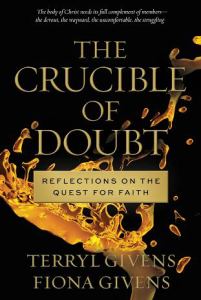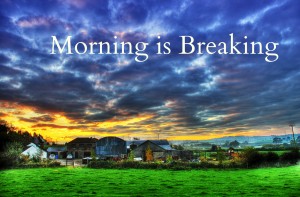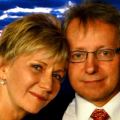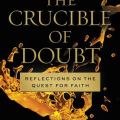I was asked to review a new book published by Deseret Books, called The Crucible of Doubt, by Terry and Fiona Givens. We were given a free copy, asked to read it, and write an honest review.
The purpose of this review is to help potential readers decide if this book is right for them. I hope the following comments and concerns will be of value.
What is this book about?
When I picked up this book I read the front jacket and inside flap. On the front it states, “The body of Christ needs its full complement of members—the devout, the wayward, the uncomfortable, the struggling.” I agree with this statement as I know Heavenly Father loves all his children and salvation is not meant for an elect few. The members of the Quorum of the Twelve Apostles tell us so at each conference, inviting all to come unto Christ. After opening the book and reading the inside flap, I got an idea of the main theme of the book—tackling the question of doubt when it comes to your faith or your testimony. So between the two snippets, I concluded the book would be a guide for those who are struggling with their testimonies as it takes on the hard questions deep in the hearts of members at all levels of spiritual development.
As I read further, I would test my theory—is that truly what the book represents, and is it for everybody?
Introduction
The authors begin with an intriguing analogy—vivid and poignant to their theme. They wrote about the Mossman door, a door on the third floor of a wealthy home in sixteenth century Scotland which had a false keyhole. The true keyhole was cleverly hidden from sight so that potential thieves would be thwarted from finding the treasures locked behind the door. Anyone with a key, even a master skeleton key, would be denied entrance no matter how carefully they used it, for the keyhole was false. The true keyhole was hidden behind a metal bar directly to the left of the false one. The authors made the comparison that finding truth is often times marred when searchers waste time muddling through world paradigms that are based in false precepts and traditions. We see the glass darkly, rather than look through it clearly. And the more errors obstructing our view, the harder it is to even find the right questions to ask. The analogy intrigued me as it described my own search for truth.
The meat of the book
 Each chapter introduces a false paradigm that may have hindered a person’s quest for faith. The chapter titles are quite fascinating and are listed as follows: the Use and Abuse of Reason, Of Life’s Fundamental Incompleteness, The Role and Function of the Church, The Use and Abuse of Scripture, The Perils of Hero Worship, The Ring of Pharaoh, Holy Persons “Ye Know Not Of”, Find Your Watering Place, Rethinking Being “Overcome by Evil”, “Speak Lord, for Thy Servant Heareth,” and “Belief as Risk.” These topics may sound obscure, but after careful analysis, they are indeed topics that our General Authorities have address in the past and present—they are simply presented in a more academic rhetoric. After the topic is presented, the authors then counter the argument with an array of information to direct the reader toward seeing the gospel principle.
Each chapter introduces a false paradigm that may have hindered a person’s quest for faith. The chapter titles are quite fascinating and are listed as follows: the Use and Abuse of Reason, Of Life’s Fundamental Incompleteness, The Role and Function of the Church, The Use and Abuse of Scripture, The Perils of Hero Worship, The Ring of Pharaoh, Holy Persons “Ye Know Not Of”, Find Your Watering Place, Rethinking Being “Overcome by Evil”, “Speak Lord, for Thy Servant Heareth,” and “Belief as Risk.” These topics may sound obscure, but after careful analysis, they are indeed topics that our General Authorities have address in the past and present—they are simply presented in a more academic rhetoric. After the topic is presented, the authors then counter the argument with an array of information to direct the reader toward seeing the gospel principle.
The authors use various literary and scholarly means to support their points. Each chapter has a wealth of information, including lengthy poetic verse, an abundance of references from LDS and non-LDS people in history, even LDS references that are not as well known to the average Latter-day Saint. As I read deeper and further, I could not help but ask myself, “Who is the targeted audience for this book?” The tone and style are highly intellectual. The references are sometimes so obscure they are more confusing than enlightening. And often times the authors generalize about what “many Mormons believe”—pigeon-holing us in cultural stereotypes that are simply not true across the spectrum of this world-wide body of people.
Intellect vs. personal revelation
As I continued to read, I found the scholarly style and the intellectual calisthenics to be a bit more challenging for the average reader, which might cause more doubt than clarity. It was as if each chapter presented itself as a new Mossman door, where I was standing there with the right key, working the wrong keyhole to find the answers. Perhaps my background as an adult convert to the church living on the East Coast has put me in a position to look at doubt differently. I did not grow up in the culture often referred to by the authors. Each year’s General Conference added knowledge and edification to my testimony, drop by drop, as I would continue to confirm the correctness of my decision to join the church based on true principles from living prophets. Spiritual confirmation, to me is not a game of intellect, but a personal process unique to the individual that cannot be denied once it is made manifest. I learned early on from the missionaries and from many teachers of gospel doctrine and principles to look at the restored gospel this way—doubt and questions were two different things. I always had questions; I never had doubts. I also spent the last 25 years contending with anti-Mormon family members, which continued to harass me about doctrine and prejudice against the church. All I really had was the standard works, General Conference, prayer and the Gift of the Holy Ghost to combat their attacks. In utilizing the tools I had, my testimony grew based on faith and personal revelation. So my background is quite different from the targeted reader.
It became clear to me that this is a book that may have a specific audience of which I am not a member. Likewise, I did not feel it to be a good match for those who are struggling with their testimony. Perhaps it would be of interest to those who have questions, but series doubts can never be resolved intellectually—only by developing a personal relationship with Heavenly Father.
Once I realized this book is more of an intellectual work-out than a spiritual haven for the weary, I was able to appreciate it from an educational standpoint. There are people who will find this a stimulating read, and I will do my best to focus on its attributes for their benefit.
Next week I will highlight certain aspects of the book, The Crucible of Doubt, pointing out features that are enriching and edifying, as well as places wherein the authors miss the mark, in my opinion.
About Nanette ONeal
Nanette O'Neal loves the gospel and is very happy to share her testimony on LDS Blogs. She is a convert to the church and still feels the spirit burn strong within her heart. She graduated from Mason Gross School of the Arts with a degree in music education and has taught children and adults in the private and public sphere for over twenty years. Nanette continues to study the gospel and the art of writing. She writes weekly inspirational articles on her blog and is currently working on an LDS fantasy novel series, A Doorway Back to Forever. You can find her at NanetteONeal.blogspot.com. Nanette has a wonderful husband, talented son, and three beautiful dogs.









Great insights, Nanette…